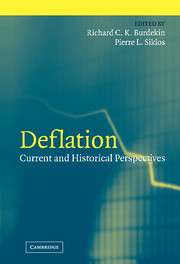Book contents
- Frontmatter
- Contents
- List of Tables and Figures
- List of Contributors
- Preface
- 1 Fears of Deflation and the Role of Monetary Policy: Some Lessons and an Overview
- PART ONE FEARS OF DEFLATION AND THE ROLE OF MONETARY POLICY
- PART TWO DEFLATION AND ASSET PRICES
- 5 Boom–Busts in Asset Prices, Economic Instability, and Monetary Policy
- 6 Deflation, Credit, and Asset Prices
- PART THREE INTERNATIONAL PERSPECTIVES ON DEFLATION
- PART FOUR STOCK MARKET ADJUSTMENTS TO DEFLATION
- References
- Index
- Titles in the series
5 - Boom–Busts in Asset Prices, Economic Instability, and Monetary Policy
Published online by Cambridge University Press: 15 December 2009
- Frontmatter
- Contents
- List of Tables and Figures
- List of Contributors
- Preface
- 1 Fears of Deflation and the Role of Monetary Policy: Some Lessons and an Overview
- PART ONE FEARS OF DEFLATION AND THE ROLE OF MONETARY POLICY
- PART TWO DEFLATION AND ASSET PRICES
- 5 Boom–Busts in Asset Prices, Economic Instability, and Monetary Policy
- 6 Deflation, Credit, and Asset Prices
- PART THREE INTERNATIONAL PERSPECTIVES ON DEFLATION
- PART FOUR STOCK MARKET ADJUSTMENTS TO DEFLATION
- References
- Index
- Titles in the series
Summary
INTRODUCTION
The link between monetary policy and asset price movements has been of perennial interest to policy makers. The 1920s stock market boom and 1929 crash and the 1980s Japanese asset bubble are two salient examples in which asset price reversals were followed by protracted recessions and deflation. The key questions that arise from these episodes is whether the monetary authorities could have been more successful in preventing the consequences of an asset market bust or whether it was appropriate for the authorities only to react to these events ex post.
In this chapter we consider the potential cases for proactive versus reactive monetary policy based on the situation in which asset price reversals can have serious effects on real output.
Our analysis is based on a stylized model of the dilemma with which the monetary authorities are faced in asset price booms. On the one hand, letting the boom go unchecked entails the risk that it will be followed by a bust accompanied by a collateral-induced credit crunch. Restricting monetary policy can be thought of as insurance against the risk of a credit crunch. On the other hand, this insurance does not come free: Restricting monetary policy implies immediate costs in terms of lower output and inflation. The optimal monetary policy depends on the relative cost and benefits of the insurance.
Although the model is quite stylized, we find that the optimal monetary policy depends on the economic conditions – including the private sector's beliefs – in a rather complex way.
- Type
- Chapter
- Information
- DeflationCurrent and Historical Perspectives, pp. 131 - 165Publisher: Cambridge University PressPrint publication year: 2004
- 6
- Cited by



